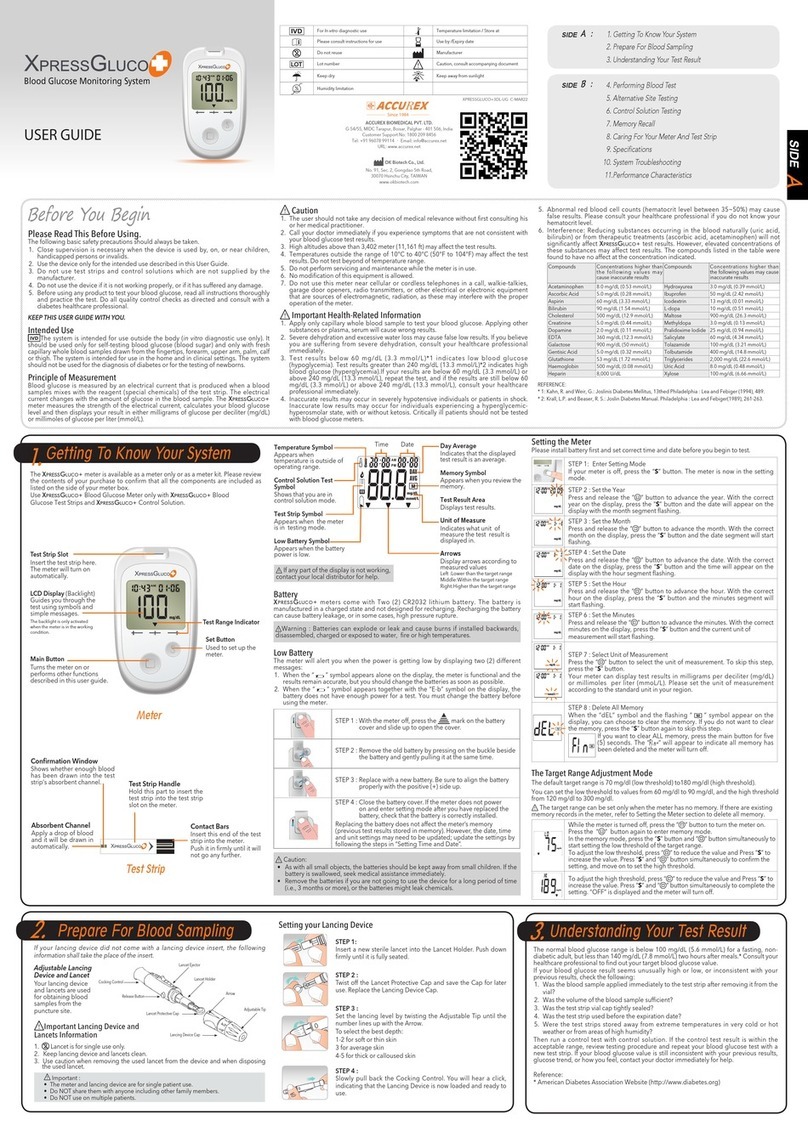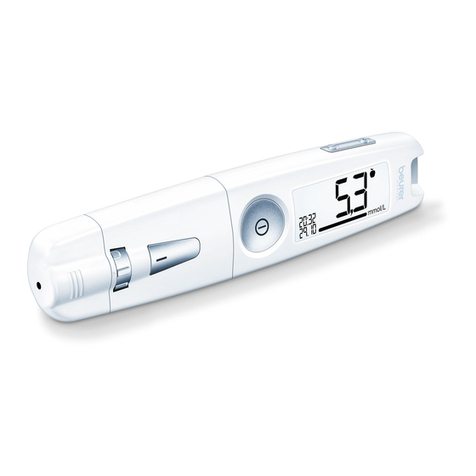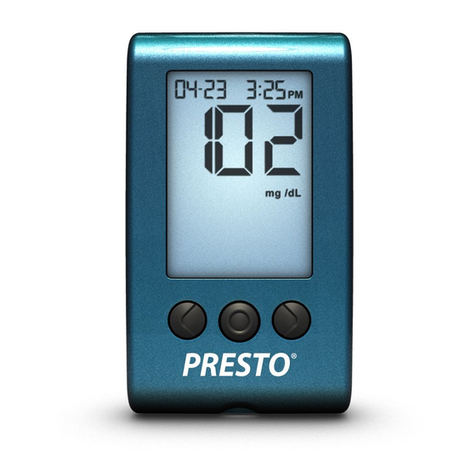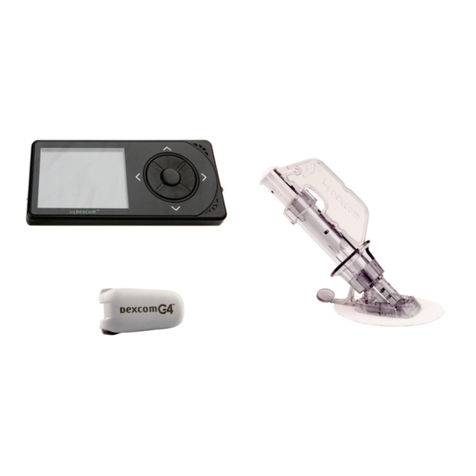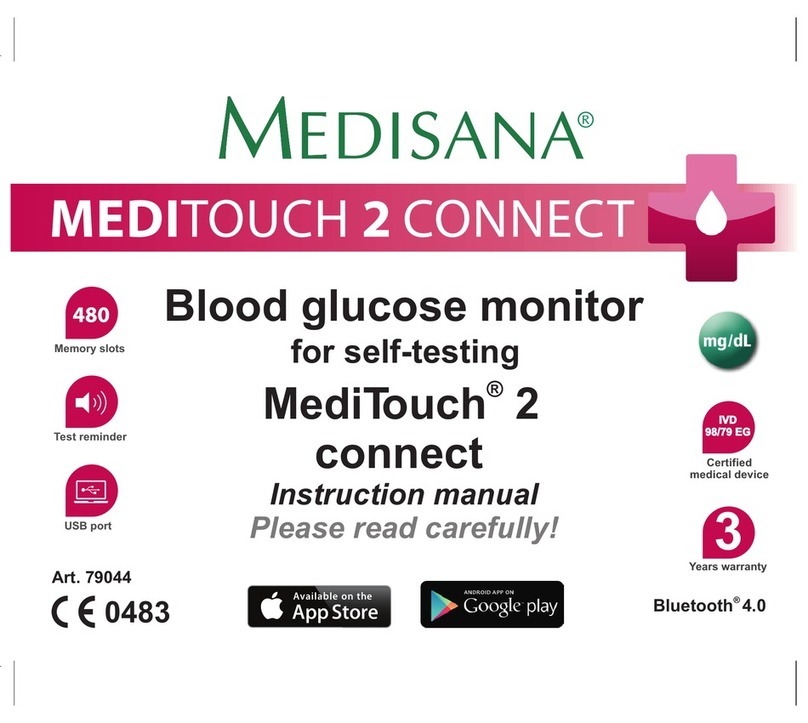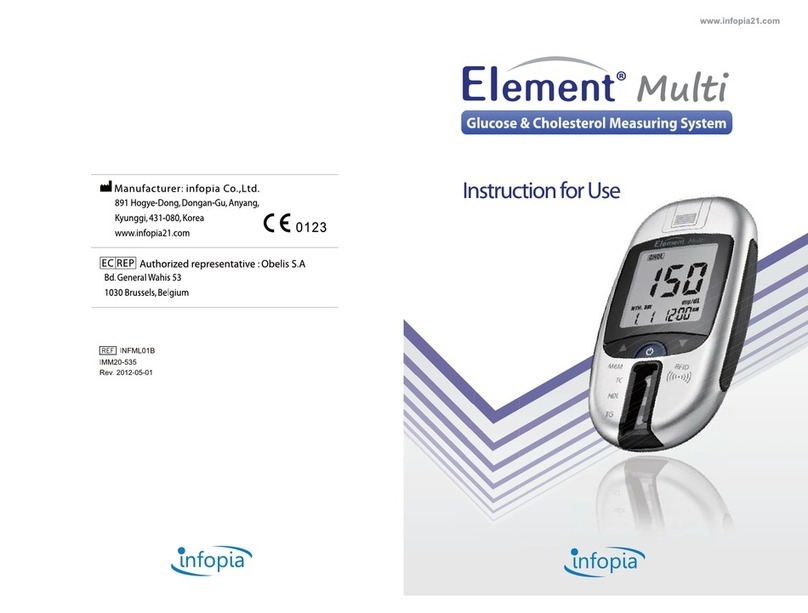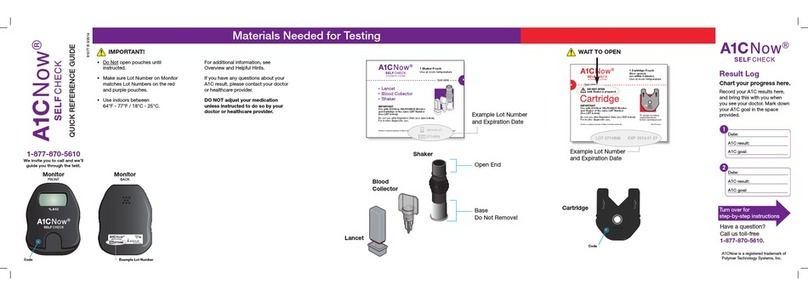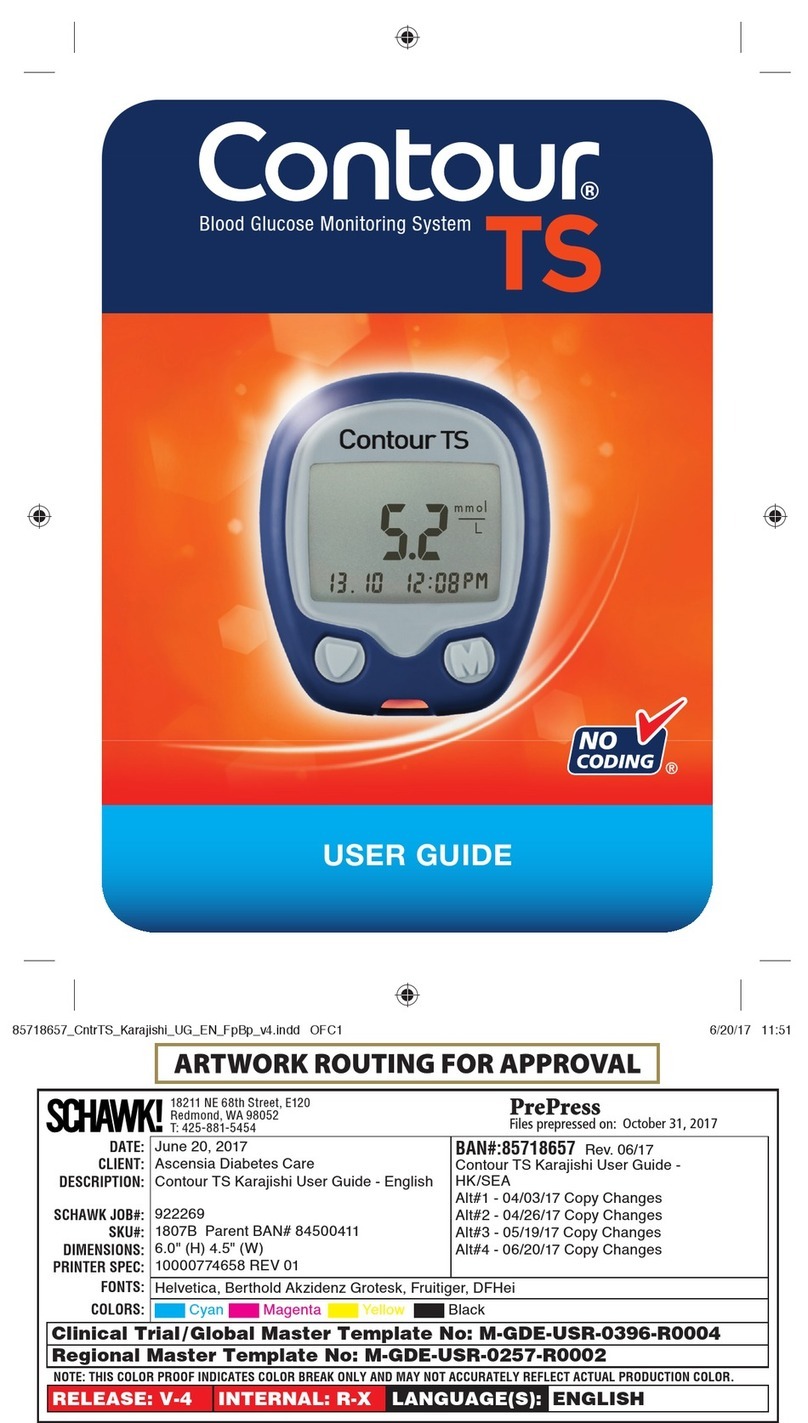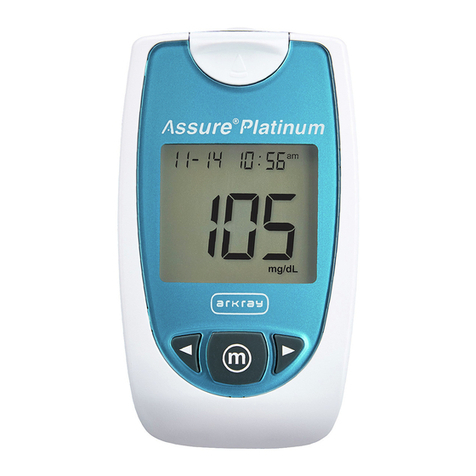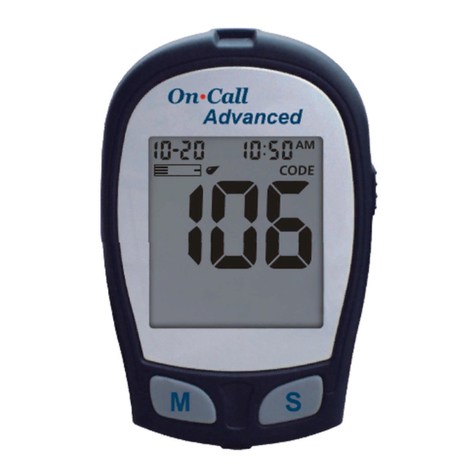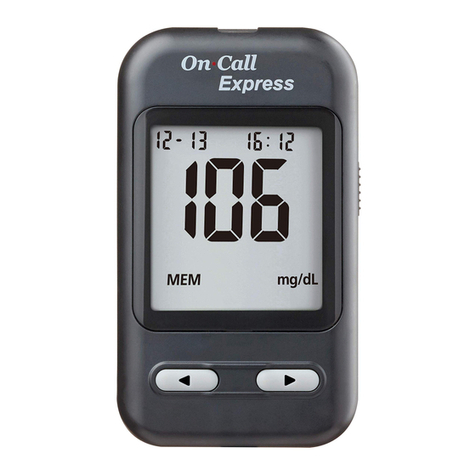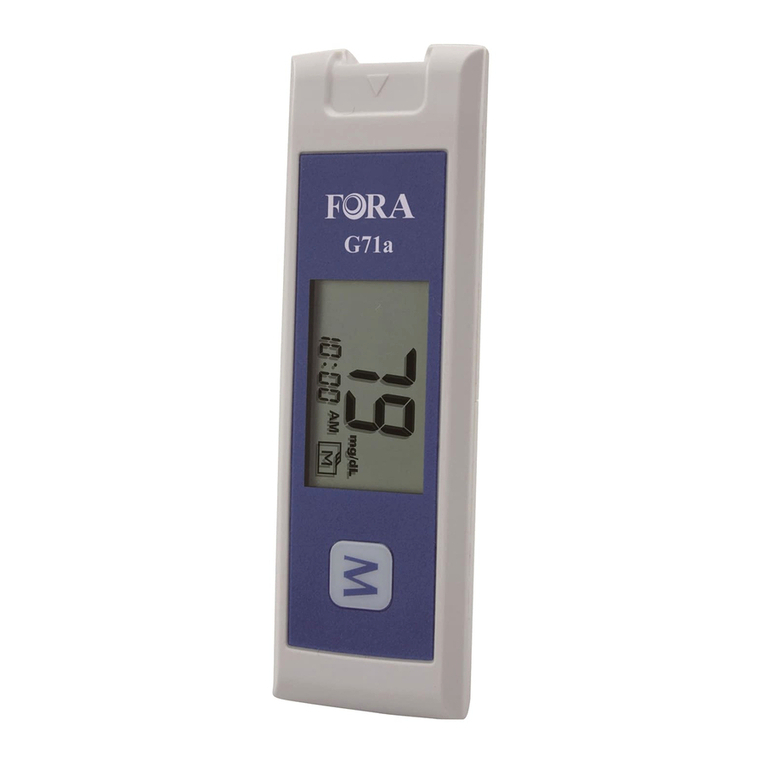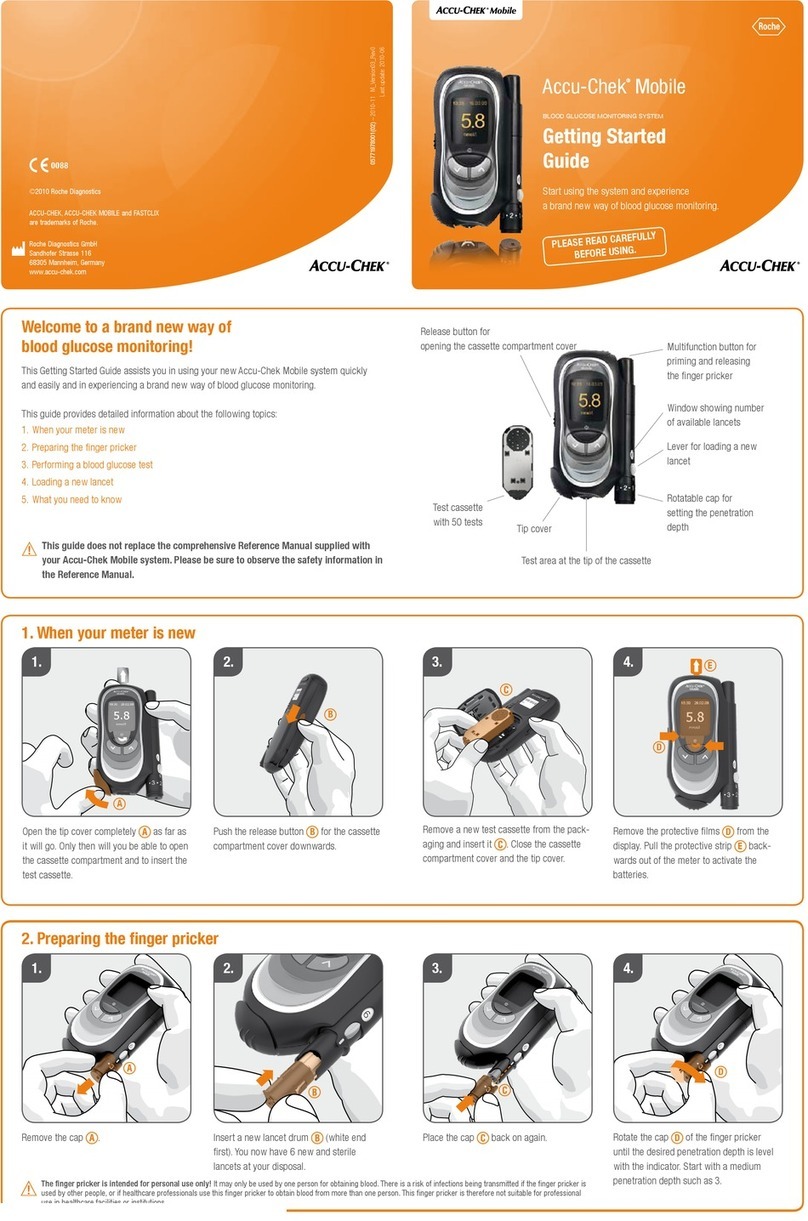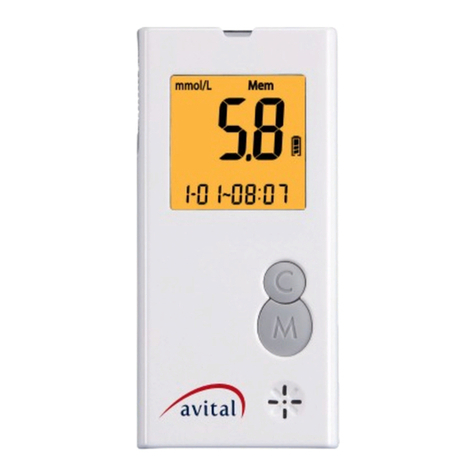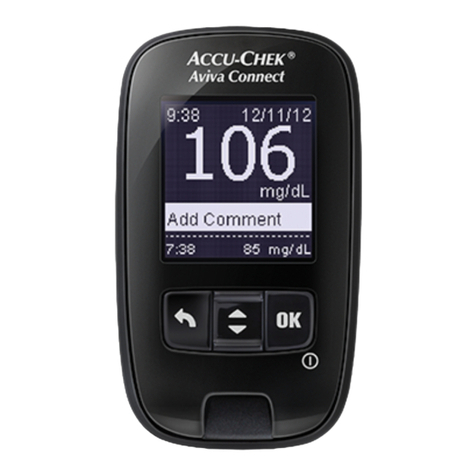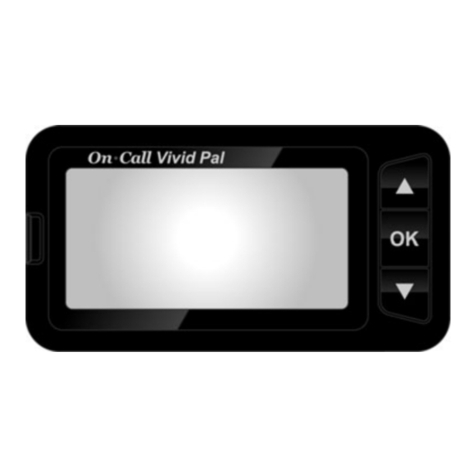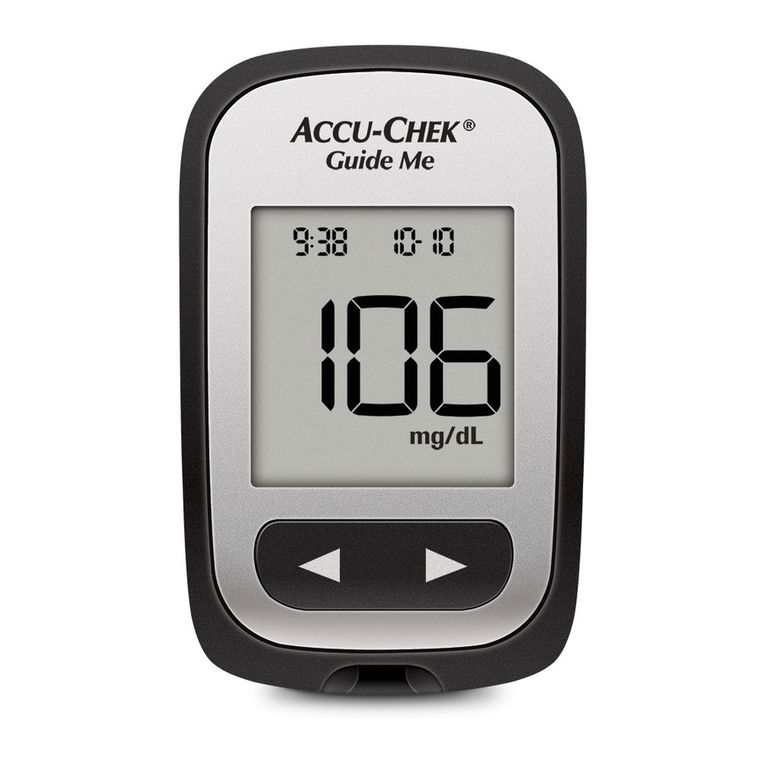OK Biotech OKmeter Direct User manual

SIDE
Before You Begin
PLEASE READ THIS BEFORE USING.
The following basic safety precautions should always be taken.
1. Close supervision is necessary when the device is used by, on, or near children,
handicapped persons or invalids.
2. Use the device only for the intended use described in this User Guide.
3. Do not use test strips and control solutions which are not supplied by the
manufacturer.
4. Do not use the device if it is not working properly, or if it has suffered any damage.
5. Before using any product to test your blood glucose, read all instructions
thoroughly and practice the test. Do all quality control checks as directed and
consult with a diabetes healthcare professional.
6. KEEP THIS USER GUIDE WITH YOU.
Intended Use
The system is intended for use outside the body (in vitro diagnostic use only).
It should be used only for testing blood glucose (blood sugar) and only with fresh
capillary whole blood samples. The system is intended for use in the home and in
clinical settings. It should not be used for the diagnosis of diabetes or for the testing of
newborns.
Getting To Know Your System
The OKmeter Direct Blood Glucose Monitoring System.
The OKmeter Direct system uses the latest technology to provide you with easy and
comfortable testing. The system requires only a 0.7 μL of blood sample to complete
the testing in only 6 seconds.
The OKmeter Direct system consists of
1. OKmeter Direct Blood Glucose Meter
2. OKmeter Direct Blood Glucose Test Strips
Principle of Measurement
Blood glucose is measured by an electrical current that is produced when a blood
samples mixes with the reagent (special chemicals) of the test strip. The electrical
current changes with the amount of glucose in the blood sample. The OKmeter Direct
meter measures the strength of the electrical current, calculates your blood glucose
level and then displays your result in either milligrams of glucose per deciliter (mg/dL) or
millimoles of glucose per liter (mmol/L).
Caution
1. The user should not take any decision of medical relevance without rst consulting
his or her medical practitioner.
2. Call your doctor immediately if you experience symptoms that are not consistent with
your blood glucose test results.
3. High altitudes above than 3,402 meter (11,161 ft) may affect the test results.
4. Temperatures outside the range of 10°C to 40°C (50°F to 104°F) may affect the test
results. Do not test beyond of temperature range.
IMPORTANT HEALTH-RELATED INFORMATION
1. Apply only capillary whole blood sample to test your blood glucose. Applying other
substances or plasma, serum will cause wrong results.
2. Severe dehydration and excessive water loss may cause false low results. If
you believe you are suffering from severe dehydration, consult your healthcare
professional immediately.
3. Test results below 60 mg/dL (3.3 mmol/L)*1 indicates low blood glucose
(hypoglycemia). Test results greater than 240 mg/dL (13.3 mmol/L)*2 indicates high
blood glucose (hyperglycemia).If your results are below 60 mg/dL (3.3 mmol/L) or
above 240 mg/dL (13.3 mmol/L), repeat the test, and if the results are still below 60
mg/dL (3.3 mmol/L) or above 240 mg/dL (13.3 mmol/L), consult your healthcare
professional immediately.
4. Inaccurate results may occur in severely hypotensive individuals or patients
in shock. Inaccurate low results may occur for individuals experiencing a
hyperglycemic-hyperosmolar state, with or without ketosis. Critically ill patients
should not be tested with blood glucose meters.
5. Abnormal red blood cell counts (hematocrit level below 20% or above 60%) may
cause false results. Please consult your healthcare professional if you do not know
your hematocrit level.
6. Interference: Reducing substances occurring in the blood naturally (uric acid,
bilirubin) or from therapeutic treatments (ascorbic acid, acetaminophen) will not
signicantly affect OKmeter Direct test results. However, elevated concentrations
of these substances may affect test results. The compounds listed in the tables
were found to have no affect at the concentration indicated.
Compounds Highest concentrations
tested at which no
interference occured
Compounds Highest concentrations tested
at which no interference
occured
Acetaminophen ≦ 8.0 mg/dL (0.53 mmol/L) Gentisic Acid ≦ 5.0 mg/dL (0.32 mmol/L)
Ascorbic Acid ≦ 5.0 mg/dL (0.28 mmol/L) Hydroxyurea ≦ 3.0 mg/dL (0.39 mmol/L)
Aspirin ≦ 60 mg/dL (3.33 mmol/L) L-dopa ≦ 10 mg/dL (0.51 mmol/L)
Bilirubin ≦ 90 mg/dL (1.54 mmol/L) Maltose ≦ 900 mg/dL (26.3 mmol/L)
Cholesterol ≦ 500 mg/dL (12.9 mmol/L) Methyldopa ≦ 3.0 mg/dL (0.13 mmol/L)
Creatinine ≦ 5.0 mg/dL (0.44 mmol/L) Tolbutamide ≦ 400 mg/dL (14.8 mmol/L)
Dopamine ≦ 2.0 mg/dL (0.11 mmol/L) Triglycerides ≦ 2,000 mg/dL (22.6 mmol/L)
Galactose ≦ 900 mg/dL (50 mmol/L) Uric Acid ≦ 8.0 mg/dL (0.48 mmol/L)
REFERENCE:
* 1: Kahn, R. and Weir, G.: Joslinis Diabetes Mellitus, 13thed Philadelphia : Lea and Febiger (1994), 489.
* 2: Krall, L.P. and Beaser, R. S.: Joslin Diabetes Manual. Philadelphia : Lea and Febiger(1989), 261-263.
1. TEST STRIP SYMBOL: Appears when the
meter is turned on and waiting for inserting a
test strip.
2. VOICE SYMBOL
3. BATTERY SYMBOL: Appears when battery is
weak.
4. BLOOD DROP SYMBOL: Flashes when it is
ready to apply the blood sample.
5. MEASUREMENT UNIT: Appears with the test
result in mg/dL or mmol/L.
6. Ketone?: Appears when result is higher than
240 mg/dL (13.3 mmol/L).
7. : Appears when test result is within the range
of 70 to 120 mg/dL (3.9 mmol/L to 6.7 mmol/L).
8. AVERAGE: Appears in the memory mode while recalling 7/14/21/28 day test
averages.
9. MEMORY SYMBOL: Appears when in the memory mode.
10. CTL SYMBOL: Appears when doing a control sloution test.
11. TIME : The meter is programmed for a 12 hour period format.
12. DATE: Display month and date.
13. AND LOW SIGN: Appears when test result is within the range of 20 to 70 mg/dL
(1.1 mmol/L to 3.9 mmol/L).
14. AND HIGH SIGN: Appears when test result is higher than 120 mg/dL (6.7 mmol/L).
15. THERMOMETER SYMBOL: Appears when ambient temperature is above or below
the acceptable range needed for testing.
1.
A
1
. Getting To Know Your System
2. Prepare For Blood Sampling
3. Performing Blood Test
4. Understanding Your Test Result
5. Memory Recall
6. Control Solution Testing
7. System Specifications
8. Caring For Your Meter And Test Strip
9. Display Messages And Problem-Solving Guide
SIDE
A :
SIDE
B :
Test Strip
ABSORBENT
CHANNEL:
Apply a drop of
blood here.
CONTACT BARS:
Insert this end into strip slot.
TEST STRIP HANDLE :
Hold this part to insert the test strip
into the meter slot.
CONFIRMATION WINDOW:
This is where we conrm if enough blood is applied for the
test. Ensure that it is fully covered with blood sample.
How to replace the battery
1. Make sure the meter is turned off. Let the front of the meter
rest in the palm of your hand. Slide battery cover open.
S
2. Remove the old batteries and replace with two (2) new 1.5V
AAA size alkaline batteries.
3. Close battery cover.
NOTE:
1. Replacing the battery does not affect the test result stored in memory. However the
time and date may need to re-set.
2. As with all small objects, the battery should be kept away from small children as a
safety precaution. If the battery is swallowed, seek medical assistance immediately.
3. Batteries might leak chemicals if not used for a long time. Remove the batteries if
you are not going to use the device for extended (i.e., 3 months or more ).
4. Please discard the product or the batteries properly according to the regulations
of your country.
For
In vitro
diagnostic use Temperature limitation / Store at
Please consult instructions
for use Use by /Expiry date
Do not reuse Manufacturer
Lot number EU representative
Caution, consult
accompanying document
This product fulls the requirements of
Directive 98/79/EC
In vitro
diagnostic
medical device.
Performance Characteristics:
ACCURACY: More than ninety-ve percent (95 %) of the individual glucose results fell within ± 0.83 mmol/L (15 mg/dL) of the
results of the glucose analyzer YSI 2300 measurement procedure at glucose concentrations < 4.2 mmol/L (< 75 mg/dL) and
within ± 20 % at glucose concentrations ≧4.2 mmol/L ( ≧75 mg/dL).
PRECISION: CVs (%) of intermediate precision and repeatability were less than 5%.
1
3
2
4
5
6
7
8
11
12
13
14
15
10
9
Code
REPLACING THE BATTERY
The OKmeter Direct meter comes with TWO 1.5V AAA alkaline batteries.
Battery life will vary depending on usage, so always keep spare batteries on hand.
The battery should last about 1000 tests or 12 months when testing 3 times a day.
When the batteries symbol appears on the meter display, battery is getting low. You will
still be able to test with low battery, but you should replace them as soon as possible.
When battery symbol and E-b shows up in the meter display, the meter will no longer
give results and you must replace the batteries immediately. Please always have spare
batteries with you to ensure that you can replace the battery anytime.
SETTING TIME AND DATE
Please install battery rst and set correct time and date before you begin to test.
SET
STEP 1. Enter Setting Mode
Start with the meter off. Open the battery compartment, and press SET
BUTTON. The meter will turn on and enter the setting mode.
STEP 2. Set the Year
The year appears with the number ashing. Press and release the M
BUTTON to obtain the desired year. Press SET BUTTON to confirm
and move to next MONTH setting.
STEP 3. Set the Month
The month appears with the number ashing. Press and release the M
BUTTON to obtain the desired month. Press SET BUTTON to conrm
and move to next DATE setting.
STEP 4. Set the Date
The date appears with the number ashing. Press and release the M
BUTTON to obtain the desired date. Press SET BUTTON to confirm
and move to next HOUR setting.
STEP 5. Set the Hour
The hour appears with the number ashing. Press and release the M
BUTTON to obtain the desired hour. Press SET BUTTON to confirm
and move to next minutes setting.
STEP 6. Set the Minutes
The minute appears with the number ashing. Press and release the M
BUTTON to obtain the desired minute. Press SET BUTTON to conrm
and the meter will enter to next unit setting.
STEP 7. Set the Unit of Measurement
The existing unit (for example mg/dL) will appear and flash. You can
choose to reset measurement unit. If you do not want to change unit,
press SET BUTTON to skip this step. If you want to change unit, press
and hold the M BUTTON for 3 seconds to change the unit to mmol/L.
Press SET BUTTON to conrm and the meter will enter to next setting.
STEP 8. Set the Unit of Temperature
The existing unit (for example °C) will appear and ashing. Press the M
BUTTON to change the unit to °F. Press SET BUTTON to conrm and
the meter will enter to next delete all memory setting.
STEP 9. Delete Memory
When the dEL symbol and the ashing memory symbol appear on the
display, you can choose to clear the memory. If you do not want to clear
the memory, press the SET BUTTON again to skip this step. If you want
to clear ALL memory, press and hold M BUTTON for 3 seconds. The “--
-“ image will appear on the LCD screen to indicate that all memory has
been deleted.
STEP 10. Complete Setting
After delete memory, the meter will display “OFF” before shut down.
The meter setting is now completed.
IMPORTANT :
1.The time, date and unit of measurement can ONLY be changed in the setting mode. Therefore,
when you perform a blood glucose testing, it is not possible to change those parameters.
2.Your meter displays test results in milligram per deciliter (mg/dL) or millimoles of glucose per
deciliter. Use of the wrong unit of measure may cause you to misinterpret your blood glucose
level, and may lead to incorrect treatment. Please always consult with your healthcare
professionals before you reset the unit of measure.
3.While the meter is in the setting mode, if no button is pressed for 1 minute, the meter will turn off
automatically.
Prepare For Blood Sampling
Adjustable Lancing Device
Your lancing device and lancets are used for obtaining
capillary blood samples from the puncture site.
Lancet
Setting your Lancing Device
1. Screw off the cap of lancing device. Insert a
lancet into the lancet holder and push down until
it is fully seated.
2. Twist off the protective cap until it separates from
the lancet.
3. Replace the lancing device cap and set the
puncture depth to the desired number.
To select the best depth:
For delicate skin
For normal skin
For thick or callused skin
4. Pull back the Sliding Barrel until it makes a click,
and then release. If it does not click, the device
may have been cocked when the lancet was
inserted.
Protective cap
2
.
Important Lancing Device and Lancets Information
1. Lancet is for single use only.
2. Keep lancing device and lancets clean.
3. Use caution when removing the used lancet from the device and when disposing the
used lancet.
IMPORTANT : The meter and lancing device are for single patient use.
Do NOT share them with anyone including other family members !
Do NOT use on multiple patients !
User Guide
Blood Glucose Monitoring System
Blood Glucose Monitoring System
New
10-62-6219-0003 V1-AUG13
OK Biotech Co., Ltd.
4F-1, No. 83, Sec. 2, Gongdao 5th Rd.,
Hsinchu City 30070, Taiwan
TEL: +886-3-5160258
FAX: +886-3-5160028
www.okbiotech.com
MDSS GmbH
Schiffgraben 41, D-30175
Hannover, Germany
Meter
S
OK1NJ005001
Model Name: OK-1N Made in Taiwan
Battery : 1.5 V AAA x 2
OK Biotech Co., Ltd.
www.okbiotech.com
For self-testing.
10-62-6263-0103 V1-AUG13
DISPLAY :
The large, easy
to read display
shows test results,
messages, test
results stored in
memory.
STRIP SLOT :
Insert the test strip here.
The meter will turn on
automatically.
SET BUTTON :
Located in the battery compartment; press button
to enter meter setting. Refer to “SETTING YOUR
METER” section of this use guide for details.
M BUTTON :
Main button, press button to turn the
meter on or perform other functions
described in this manual.
DATA PORT :
Allows you to transfer the information stored in the
meter to a computer to view, analyze and print.
Please contact us if you need detailed information.
METER LABEL :
Each meter has its unique
number on it. Do not alter
or tear the label off.
BATTERY
COMPARTMENT :
Holds TWO 1.5V
AAA alkaline
batteries.
Arrow
Lancet Holder
Depth Selectors
(Offer 6 levels of skin penetration)
Release Button
Lancet Ejector
Sliding Barrel
Lancing Device Cap
STRIP EJECTOR :
Slide the ejector forward
to discard the test strip.

SIDE
The following is a summary of some display messages and symbols. These messages
help to identify certain problems but do not appear in all cases when a problem has
occurred.
Improper use may cause an inaccurate result without producing an error message.
In the event of a problem, refer to information under ‘‘action to take’’
DISPLAY DESCRIPTION ACTION TO TAKE
Code
Display check
If some parts of the display are not
working. Contact your local distributor
for help.
Display check Meter is in the program check, wait to
next meter display.
Display temperature Appears current ambient temperature.
Blinking Strip The meter is waiting for test strip be
insert.
Blinking Blood The meter is ready for blood applying
into test strip.
Display Messages And Problem-Solving Guide
9
.
B
System Specifications
Model Name OK-1N
Assay Method Electrochemical biosensor
Test Sample Capillary Whole Blood
Test Result Referenced to plasma glucose value
Alternative Site Testing YES (palm, forearm, upper arm, calf, or thigh)
Sample Size 0.7 μL
Measuring Time 6 seconds
Measuring Range 20 – 600 mg/dL (1.1 – 33.3 mmol/L)
Acceptable Hematocrit Range 20~60%
Operating Condition 10°C~40°C(50°F~104°F), between 10-85% R. H.
Storage/Transportation Condition
4°C~40°C(39°F~104°F), between 10-85% R. H.
Memory Capacity 180 test results with time and date
Average Calculation 7, 14, 21,and 28 days
Power Supply 1.5-volt AAA Battery x 2
Battery Life Approximately 1,000 tests
Automatic shut-off In 3 minutes
Dimensions 107 x 50 x 19 mm
Weight Approximate 75 g (with battery)
7
.
8
.
Memory Recall
The OKmeter Direct automatically stores 180 test results, letting you review them
in order from the most recent to the oldest. The meter also calculates and displays
7, 14, 21, and 28-day averages. You can review the individual or average test result
by entering the memory mode.
STEP 1. Enter the Memory Mode
While the meter is turned off, press M BUTTON for twice to
enter memory mode.
STEP 2. Recalling Average Test Results
When entering the memory mode, the 7-day average will
appear. If you continue to press the M BUTTON, the 14-day,
the 21-day, and the 28-day averages will display in order.
STEP 3. Recalling Individual Test Results
After 28-day average, the most recent test result with date
and time will be shown. Press M BUTTON once and the next
most recent test result will appear. Each time you press and
release the M BUTTON, the meter will recall up to your last
180 test results in order. When the memory is full, the oldest
result is dropped as the newest is added.
STEP 4. Exit the Memory Mode
After reaching the last set of result, the meter will turn Off.
Anytime in the memory mode, you can press and hold M
BUTTON for three (3) seconds to turn off the meter.
NOTE :
1.The control solution results are NOT stored in the memory if you preset the
control test correctly. (Please refer to the “CONTROL SOLUTION TEST”
Section for details). The list of past results and the result average are for blood
glucose results only.
2.When using the meter for the rst time, ‘‘----‘’ is displayed. When you recall the
test results or review the average result, it means that there is no test result in
memory.
3.The averages are calculated from your latest result obtained during the last 7,
14, 21, and 28 days.
4. Anytime in memory mode, you can press M BUTTON for 3 seconds to exit the
memory mode.
5. While in the memory mode, if you leave the meter alone without any action for
one (1) minute, the meter will turn off automatically.
5
.
Understanding Your Test Result
The normal blood glucose range is below 100 mg/dL (5.6 mmol/L) for a fasting,
non-diabetic adult, but less than 140 mg/dL (7.8 mmol/L) two hours after meals.*
Consult your healthcare professional to nd out your target blood glucose value.
If your blood glucose result seems unusually high or low, or inconsistent with your
previous results, check the following:
1. Was the blood sample applied immediately to the test strip after removing it from
the vial?
2. Was the volume of the blood sample sufcient?
3. Was the test strip vial cap tightly sealed?
4. Was the test strip used before the expiration date?
5. Were the test strips stored away from extreme temperatures in very cold or hot
weather or from areas of high humidity?
Then run a control test with OKmeter control solution. If the control test result
is within the acceptable range, review testing procedure and repeat your blood
glucose test with a new test strip. If your blood glucose value is still inconsistent
with your previous results, glucose trend, or how you feel, contact your doctor
immediately for help.
*American Diabetes Association
(http://www.diabetes.org/diabetes-basics/prevention/pre-diabetes/diagnosis.html)
4
.
Test result with a sign. Appears when result falls in
70-120 mg/dL (3.9-6.7 mmol/L).
Test Result with low and
sign.
Appears when result is lower than
70 mg/dL (3.9 mmol/L).
Test Result with high and
sign.
Appears when result is higher than
120 mg/dL (6.7 mmol/L).
Test Result with high,
and KETONE? sign.
Appears when result is higher than
240 mg/dL (13.3 mmol/L). This is to
remind Type 1 Diabetic that the glucose
value is high and there is a risk of
ketosis. Please call medical assistance
immediately.
Test result is lower than 20
mg/dL (1.1 mmol/L).
High or low blood glucose levels can
indicate a possibly serious medical
condition. If this is not confirmed by
the way you feel, review proper testing
procedure and perform a control test.
Repeat blood test, if the display still
appears, please call medical assistance
immediately. .
Test result is higher than
600 mg/dL (33.3 mmol/L).
No memory There is no memory in the meter.
Battery is dead Replace battery now.
Maybe:
1. Used strip or moistened
strip
2. Defective meter.
You have to:
1. Repeat test with a new test strip.
2. Contact your local distributor for
help.
Temperature is out of the
operating range.
The meter is not working. Move to an
area with temperature between 10ºC to
40ºC (50ºF - 104ºF) and wait at least 30
minutes. Do not artificially heat or cool
the meter.
The test strip was removed
when meter is counting
from 06 to 01.
Repeat test with a new test strip.
No responses
when test strip
is inserted into
the meter.
There are multiple potential
causes :
1. Battery is dead.
2. Wrong strip was inserted.
3. Meter is defective.
Depending on the cause, please take
these given actions :
1. Replace the battery.
2. Insert the test strip correctly.
3. Contact us for help.
No responses
when blood
sample is
applied to the
test strip.
Maybe:
1. Blood sample is not
sufcient.
2. Meter is defective.
Please repeat the test with sufficient
blood volume. If you still see the same
results, please contact us for help.
Performing Blood Test
1. Wash Your Hands and the Puncture Site : Wash your
hands in warm, soapy water. Rinse and dry completely.
Warm your ngers to increase blood ow.
2. Insert Test Strip : Remove a new test strip from vial. Be
sure to tightly replace vial cap after removing test strips.
Insert test strip immediately into strip slot as illustrated.
The meter turns on automatically. When the blood
symbol blinking, you are ready to perform a test.
3. Wait for blood symbol blinking : When the blood
symbol blinks, you are ready to perform a test.
4. Select and Lance a Puncture Site
Hold the prepared lancing device rmly against the side
of your ngertip. Press release button.
5. Obtain a Blood Sample : Gently massage your nger
or puncture site to obtain the required blood volume.
To perform the test, you need only 0.7 μL of blood
sample. Do not smear the blood sample. To obtain
best accurate result, wipe off the rst drop of blood and
gently squeeze another drop of blood.
6. Apply Blood Sample : Apply the blood sample to the
opening of absorbent channel of test strip until the
confirmation window is fully covered with blood. Then
the meter begins to count down and displays the test
result in 6 seconds.
7. Read Your Result :
*blood glucose value with sign
Test result will be displayed after meter counts down from 6
to 1. The meter will display a sign if the result falls in the
range of 70-120 mg/dL (3.9-6.7 mmol/L). See Figure 1.
The default value is only for your reference, please
consults your health care professional to find out your
target blood glucose value.
*blood glucose value with and low sign.
The meter will display your blood glucose value with a
and low sign if your test result is lower than 70 mg/dL
(3.9 mmol/L). See Figure 2.
*blood glucose value with and high sign
The meter will display your blood glucose value with a
and high sign if your test result is higher than 120 mg/dL
(6.7 mmol/L). See Figure 3.
*blood glucose value with , high and Ketone? sign.
The meter will display your blood glucose value with a
high and Ketone? sign if your test result is higher than
240 mg/dL (13.3 mmol/L). See Figure 4.
This is to remind Type 1 Diabetic that the glucose value
is high and there is a risk of ketosis. Please call medical
assistance immediately
8. Slide Forward Ejector : To discard the test strip, turn the
meter upside down, and Strip Ejector forward.
9. Remove the Lancing Device Cap when finished. Put
the Protective Cap back onto the exposed needle of the
lancet.
10.Direct the lancing device away from you and slide
the Lancet Ejector in a forward motion, disposing the
lancet in an approved container.
Incorrect Correct
3
.
Fig.1
Caring For Your Meter And Test Strip
8.
Do not use organic solvents to clean the meter. Your meter is a precision
instrument. Please handle it with care.
Storage
1. Meter Storage
* Storage condition: -20ºC~50ºC (-4ºF~122ºF), below 90% relative humidity.
* Avoid dropping and strong impact.
* Avoid direct sunlight and humidity.
2. Strip Storage
* Storage condition: 4ºC~40ºC (39ºF~104ºF), and 10~85% relative humidity. Do not refrigerate.
* Store your test strips in their original vial only. Do not transfer to other container.
* Store test strip packages in a cool and dry place. Keep away from direct sunlight and heat.
* After removing a test strip from the vial, immediately replace the vial cap and close it tightly.
* You may touch the test strip anywhere with clean, dry hands when removing it from the vial or
inserting it into the meter.
* Use each test strip immediately after removing it from the vial.
* Do not bend, cut, or alter a test strip in any way.
* Keep the strip vial away from children since the cap and the test strip can be a potential
choking hazard. If swallowed, please seek medical assistance immediately.
3. Control solution storage
* Storage condition: Store the control solution tightly closed at temperatures below 86ºC (30ºC).
* Do not refrigerate.
Fig.2
Fig.3
Fig.4
To avoid the meter and test strips getting dirt, dust or other contaminants, please
wash and dry your hands thoroughly before use.
Cleaning
Your meter does not require special maintenance. As long as no blood or control
solution comes in direct contact with the meter, there is no special cleaning
required.
To clean the meter exterior, wipe with a cloth moistened with tap water or a mild
cleaning agent, then dry the device with a soft and dry cloth. Do not flush with
water.
Control Solution Testing
OKmeter control solutions contain a known amount of glucose that reacts with
OKmeter test strips. By testing your control solution and comparing the test results
with the expected range printed on the test strip vial label, you can make sure that
the meter and the test strips are working properly together as a system and that you
are performing the test correctly. It is very important that you do this simple check
routinely to make sure you get accurate results.
Why perform a control solution test?
1. To ensure that your meter and test strip are working properly together.
2. To allow you to practice testing without using your own blood.
When should the control solution test be performed?
1. When you rst get your OKmeter Direct meter. Before use this system to test your
blood, you can practice the procedure by using control solution. When you can do
three tests in a row that are within the expected range, you are ready to test your
blood.
2. Once a week (to make sure that you continue to get accurate results)
3. When you begin using a new vial of test strips.
4. Whenever you suspect that the meter or test strips are not working properly.
5. When your blood glucose test results are not consistent with how you feel, or
when you think your results are not accurate.
6. When test strips are exposed to extreme environmental conditions.
7. If you drop the meter.
Important Control Solution Information
1. Check the expiration date on the control solution bottle. Do not use if expired.
2. Control solution, meter, and test strips should come to room temperature (68-
77 ºF/20-25ºC) before testing.
3. Shake the bottle before use, discard the first drop of control solution after
squeezing, wipes off the dispenser tip to avoid contaminations. These steps
ensure you will get a good sample and an accurate result.
4. Record the discard date on the bottle when you open a new bottle of control
solution.
NOTE : 1. There are two levels of control solution (normal and high) available to
purchase. Please contact with your local distributor when required.
2. The control solution range printed on the test strip vial is for OKmeter
Control Solution only. It is used to test meter and strip performance. It is
not recommended range for your blood glucose level.
How to Perform a Control Test
NOTE : 1. Be sure that you are in Control Solution Mode so that the test result will
not be stored in themeter memory.
2. DO NOT APPLY THE CONTROL SOLUTION DIRECTLY TO THE TEST
STRIP! Overdosed solution may give inaccurate result.
3. Repeat test if test result falls outside the control range stated on the test
strip label. If subsequent test remains to produce unacceptable result,
the meter or test strip may be faulty. DO NOT use the system. Contact
us or your local distributor for help.
1. Insert Test Strip : Insert a new test strip into the strip slot,
the meter will activate.
2. Mark as a Control Solution Test : After the blood
symbol( ) appears, press M BUTTON and "CTL" appears
on the display indicating you are in the Control Solution
Mode. The meter will not store your test result in the
memory when you preset the test as a control solution
test. If you decide not to perform a control solution test,
press M BUTTON again and the"CTL" will disappear.
3. Squeeze a drop of Control Solution : Shake control
solution bottle well. Remove the cap. Squeeze bottle,
discard the rst drop and wipe off the dispenser tip with
a clean tissue paper or cotton swab. Squeeze a drop on
clean bottle cap/ngertip /non-absorbent surface.
4. Apply Control Solution : Apply the drop to the opening
of the strip absorbent channel until the confirmation
window is lled. The meter begins to count down.
5. Check if the test result is in range: After the meter
counts down from 6 to 1, the test result shows up.
Compare the test result with the range printed on the test
strip vial. The result should fall within the printed range.
6
.
This manual suits for next models
1
Other OK Biotech Blood Glucose Meter manuals

